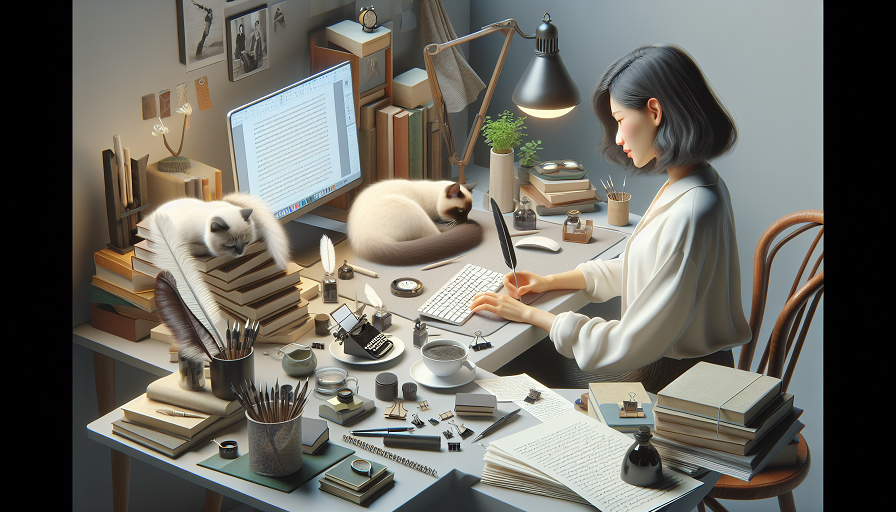
It happens in an instant. A line that seemed ordinary catches a sliver of light and suddenly refracts the entire scene. Maybe it’s a lipstick-stained coffee cup on the wrong nightstand. A child’s drawing pinned to a villain’s refrigerator. A chipped wedding band slipped quietly into a coat pocket. These aren’t loud moments. They’re quiet detonations. A single, unexpected detail—and everything changes.
This is the power of the disruptive detail. Not to decorate the page, but to reframe it. Done right, one image can upend assumptions, heighten stakes, expose secrets, or drag subtext into the spotlight. It’s not about adding more—it’s about adding meaning. Precision over volume. Surprise over spectacle.
Contents
What Is a Disruptive Detail?
First, let’s define the term. A disruptive detail is a small, specific, often sensory image that introduces emotional or narrative friction into a scene. It doesn’t just sit there—it intervenes. It causes the reader (and often the character) to pause, reassess, or feel something unexpected.
Not Just a Detail—A Decision
All stories are made of details, but not all of them disrupt. A disruptive detail breaks the surface. It’s a wrinkle in an otherwise smooth narrative. It invites interpretation, demands rereading, or foreshadows without shouting.
- It alters tone (from warm to chilling)
- It reveals contradiction (a cheerful room with a shattered photo frame)
- It exposes emotional undercurrents (a clenched fist during a smile)
- It flips reader assumptions (a priest’s Bible with bloodied edges)
Think of it as a story-altering snapshot—a visual fulcrum around which the emotional arc tilts.
The Psychology Behind Disruptive Details
Our brains are wired to seek pattern and coherence. Disruption gets our attention because it breaks expectation. In fiction, that same instinct can be used to snap the reader awake—to force a re-evaluation of the emotional or narrative truth in a scene.
Why the Unexpected Works
When a detail doesn’t “match” the scene around it, the brain stutters. Wait, what? Why is there a broken teacup on the neatly set table? That pause creates space for tension. And in fiction, tension is gold. It means the reader is leaning forward, unsettled—in the best way.
The Emotional Undercurrent
Disruptive details are emotionally charged, even when understated. They act like litmus tests for the reader’s and character’s emotional state. What does that strange object mean here, now? The disruption isn’t always sinister. It can evoke sorrow, irony, humor, or tenderness. What matters is that it changes the current.
Types of Disruptive Details
Let’s categorize the kinds of details that have the potential to shift narrative direction or deepen emotional tone. These types aren’t mutually exclusive—and often overlap in the best scenes.
1. Contradictory Details
This type juxtaposes what’s expected with what’s presented. It highlights emotional or narrative incongruity.
- A bloodstain on a birthday card
- A child’s laughter in a hospital ward
- A luxury car filled with empty fast-food wrappers
These images create instant dissonance. They force questions. They pull double duty: describing and disturbing.
2. Incongruous Objects
When something appears in a setting where it doesn’t belong, it casts a shadow over the whole scene.
- A stranger’s scarf draped over the protagonist’s chair
- A loaded gun in a drawer of tea towels
- A fresh rose in a room no one visits
These aren’t clues in a mystery—they’re cues in a psychological space. They suggest intrusion, memory, denial, or threat.
3. Behavior-Based Disruption
Not all details are objects. A character’s unexpected gesture can disrupt a scene with just as much potency.
- A teacher who flinches at applause
- A father who tears up during a car commercial
- A grieving widow laughing at a wildly inappropriate joke
Behavior-based details work best when they resist the expected emotional script. They show rather than explain.
4. Sensory Shifts
Sometimes, it’s not an object or action but a shift in sensory language that breaks the scene open.
Example:
A romantic dinner scene filled with candlelight and soft music—but the wine smells metallic. The subtle detail doesn’t belong. It plants unease. Or maybe the air tastes like dust. These details work below the conscious level to shift emotional tone.
How to Use Disruptive Details to Reshape a Scene
Now let’s look at the practical application. How do you use a single image to reframe a scene without overplaying your hand?
Start With the Baseline
Before a detail can disrupt, you need something to disrupt. That means clearly establishing the mood, setting, or emotional expectation. The cleaner the baseline, the more impactful the intrusion.
If your scene starts with warmth, introduce a cold object. If it’s casual, add formality. If it’s routine, insert anomaly. Let the scene breathe for a moment before you shift the air.
Plant, Then Pay Off
Some disruptive details work best when they’re not fully explained right away. Let them sit. Let them bother the reader. Then return to them later with clarity or emotional resonance.
Example:
Chapter 2: A teenager finds a jacket in her mother’s closet—one she’s never seen before, with an unfamiliar perfume. She mentions it, and the mother shrugs. Later, we learn the jacket belonged to the mother’s late sister. It’s not betrayal—it’s grief. And suddenly, that jacket becomes not a red herring, but a red thread.
Use Detail as Pivot
Position your disruptive image at a turning point. A moment of tension. A scene that feels too smooth. Then let it splinter. The detail becomes a gear shift—from safety to doubt, from denial to recognition.
Example:
He leaned in to kiss her goodbye. That’s when he saw it—the bruising around her wrist, the one she’d kept tucked under her sleeve all morning.
One detail, and everything spins. It’s not explained. It’s felt. That’s how disruptive details function best—as pivots of emotional weight.
How Disruptive Details Deepen Characterization
When done well, disruptive details not only reframe a scene—they deepen character psychology. They provide clues about what a character fears, desires, or hides, often without them realizing it.
The Detail That Reveals
Let a character notice something that others ignore. That detail becomes a mirror. A cop who sees a misplaced shoelace at a crime scene. A lonely child who fixates on a birthday balloon snagged in a tree. What they notice tells us who they are.
The Detail They Miss
Just as powerful: what the character doesn’t see. Let the reader catch the disruption before the character does. This creates dramatic irony—and reveals emotional blind spots.
Example:
The protagonist comes home and walks past a purse on the counter. We, the reader, notice it’s not hers. She doesn’t. Yet. That purse becomes a ticking clock.
The Detail They Create
Sometimes the character plants the disruption. Intentionally or not, they do something that shifts the scene for everyone else. A child refusing to speak at dinner. A partner lighting a cigarette after quitting. These actions act as details that speak volumes—about anger, relapse, grief, or autonomy.
Common Pitfalls and How to Avoid Them
Not every strange detail is disruptive. And not every disruption is meaningful. Here’s how to avoid missteps:
- Don’t be random: A jarring detail without emotional or narrative purpose feels gimmicky.
- Don’t overexplain: Let the reader feel the shift. Resist the urge to immediately interpret or analyze the moment.
- Don’t overuse: If every scene has a twisty image, none of them feel grounded. Use disruptive details as accents, not constant fixtures.
- Don’t sacrifice logic: The detail must be believable within the story world, even if it’s unusual. It can be strange—but it can’t be arbitrary.
Exercises to Practice Disruptive Detail
Sharpen your instinct for scene-shifting imagery with these exercises:
1. Inversion Drill
Write a paragraph describing a warm, joyful setting (a family reunion, a proposal, a birthday). Then insert one detail that doesn’t belong—but hints at deeper emotion or narrative tension. Revise the paragraph so the tone subtly changes without turning overtly dramatic.
2. Detail as Catalyst
Write a scene that seems ordinary—a morning routine, a dinner prep, a walk home. Halfway through, introduce a single visual detail that changes the character’s mood or decision. Let that one image redirect the scene’s trajectory.
3. Reframe an Existing Scene
Take a scene from your work-in-progress that feels too straightforward or emotionally flat. Insert a disruptive detail—something sensory, visual, or behavioral—and let it twist the reader’s understanding. Rewrite the end of the scene based on this shift.
The Small That Reshapes the Whole
Writers often chase the big moments—confessions, confrontations, climaxes. But some of the most unforgettable storytelling happens in the margins. In a single image. A single object. A flicker of unease that rewrites what we thought we knew.
Disruptive details aren’t about tricking the reader. They’re about layering the story. Deepening it. Giving the reader not just what’s happening—but what’s underneath. When done well, these details feel like secrets. Not shouted, but discovered.
So the next time a scene feels flat, don’t add more. Look for what you can sharpen. Shift the light. Choose the image that unsettles—and watch your scene come alive.

